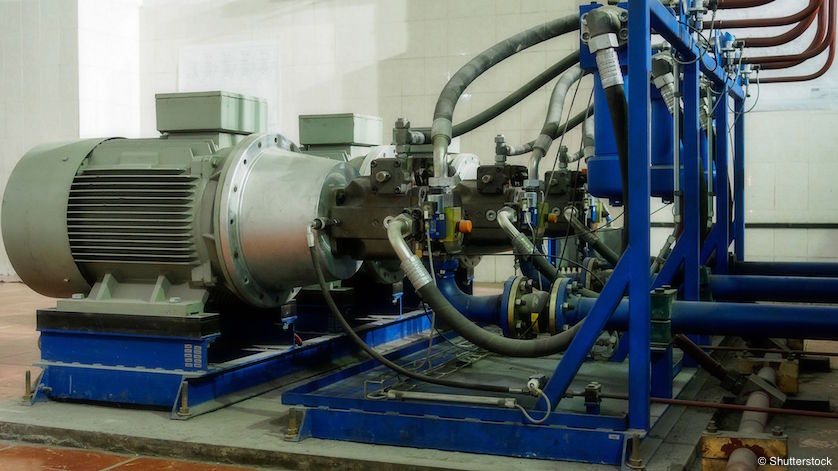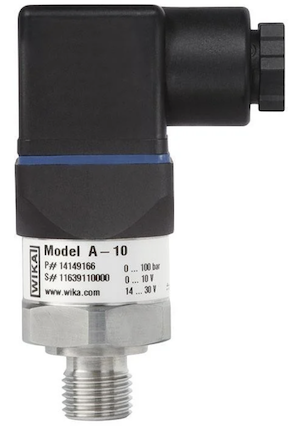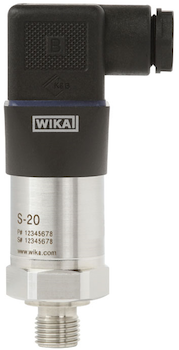
Many industrial applications rely on electronic instruments to convert pressure measurement into standard signals. The A-10 and S-20 are robust industrial pressure sensors that minimize downtimes and creates less work for field technicians.
Pressure sensors, which make up the core of electronic pressure measurement systems, are used in a wide range of industries: refrigeration, HVAC, industrial gases, food and beverage, pharmaceuticals, mobile machinery, power generation, and semiconductors – to name a few. For example, a pressure sensor in the rear suspension system of an industrial vehicle helps to ensure that the load doesn’t exceed capacity, thus preventing damage. In a hydraulic power unit, pressure sensors allow for precise control and continuous monitoring of the machinery’s valves, cylinders, motors, and other hydraulic components.
What Are Industrial Pressure Sensors, and How Do They Work?
Pressure sensors provide a stream of real-time data that is key to machinery’s safe and efficient operations. These compact yet powerful electronic devices, with a sensing element of either metal thin-film or piezo-resistive technology, first detects and quantifies the physical pressure of a critical point in a system. The sensors then covert that pressure measurement into signals that a computer or another device can read. This output signal varies depending on the application. The most common ones are are 4 … 20 mA and DC (0 … 5 V, 0 … 10 V, 1 … 5 V, 1 … 10 V, 0.5 … 4.5 V).
Electronic pressure sensors are what make predictive maintenance possible. By alerting operators when equipment needs to be serviced or replaced, companies avoid the unscheduled downtimes that disrupt production and incur unexpected expense.
Pressure sensors can be considered as the broad category that includes:
- Pressure transducers – instruments that measure pressure and then convert that reading into an electronic signal
- Pressure transmitters – instruments that also measure pressure and convert that reading into an electronic signal, with the addition of amplifying, modifying, and sending that signal to a receiver
In general, users and manufacturers apply the terms pressure sensor, pressure transducer, and pressure transmitter interchangeably.
Electronic pressure switches are also a type of pressure sensor. These devices, which can come with or without a display, carries out actions at preset switch points. For example, when an operator engages the emergency brake in a vehicle, the pressure in the brake system increases and reaches a predetermined level. The pressure switch then closes a circuit and turns on a light. That light reminds the operator to disengage the emergency brake before putting the machine back in motion.
WIKA’s Most Popular Pressure Sensors
WIKA offers a wide range of pressure sensors and transmitters designed for long-term, reliable performance. Here is a highlight of two of our most popular pressure instruments.

A-10 pressure transmitter
A-10 industrial pressure sensor
Model A-10, WIKA’s standard industrial pressure sensor, is designed to fit a broad scope of industrial and OEM pressure measurement applications. These include process control and automation, hydraulics, pneumatics, and machine controls.
The A-10 is a top-seller, thanks to its compact design and ability to measure a wide range of pressure, especially low pressure. The rugged design allows the A-10 to withstand vibration, shock, temperature fluctuations, and other environmental conditions typical of machine tools, hydraulics, pneumatics, pumps, compressors and other industrial instruments.
Soft sealing materials in other devices will deteriorate over time. The A-10’s stainless steel-welded measuring cell enhances its performance and reliability.
S-20 iIndustrial pressure sensor with custom options

S-20 pressure transmitter
For the harshest pressure demands and operating conditions, choose WIKA’s S-20 pressure transmitter. It excels in extreme environments, maintaining accuracy and performing reliably despite high pressure – up to 20,000 psi (1,600 bar) – and temperatures from −40 to +392°F (−40° to +200°C) for media and −40 to +257°F (−40° to +125°C) ambient. From arctic air and corrosive media to the shock and vibration in machine building, the S-20 is designed to handle these and other challenging conditions.
What sets the S-20 apart from other industrial pressure sensors are its numerous options for customization: different accuracy classes, extended temperature ranges on both the upper and lower ends, and customer-specific pin assignments.
WIKA also designs custom solutions when none of the off-the-shelf products can do the job. As an example, one of WIKA’s customers works regularly with high-temperature chlorinated gas for fiber optic production. The company’s standard pressure sensors were unable to withstand the environment’s high temperatures and harsh chemicals, and half of the instruments began to fail in the field. After WIKA’s product specialists came up with a custom S-20 pressure sensor solution, the client reported a 200% increase in system uptime and zero field failures.
WIKA USA, Smart in Sensing
WIKA is a global leader in smart and cost-effective sensing solutions for a variety of industrial applications. Contact us to see whether the A-10, S-20, or another electronic pressure sensor is the right choice for your applications.
Products mentioned in this article:
• A-10 pressure transmitter
• S-20 superior pressure transmitter

